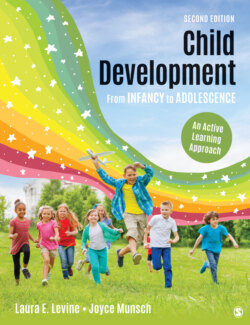Читать книгу Child Development From Infancy to Adolescence - Laura E. Levine - Страница 95
На сайте Литреса книга снята с продажи.
Why Theories of Development are Important
Оглавление>> LQ 2.1 What do child development theories tell us?
To understand how and why children develop the way they do, it is not enough simply to observe them. Our observations should lead us to explanations that allow us to predict how they will behave. These explanations can be organized into a developmental theory. As we said in Chapter 1, we all have our own personal theories about human behavior, but the theories we use to build a scientific understanding about child and adolescent development must be public and testable. Theories in any science serve two important functions: They help us organize the knowledge that we already have, and they help us make predictions that we can investigate and test.
Developmental theory: A systematic, coherent model of how humans grow from infancy through later adulthood.
For example, a parent might react very differently to an infant’s continual crying depending on his understanding of what this crying means. He might believe that picking up a crying baby rewards that behavior and will result in the baby crying even more. (You will learn more about this theory, called behaviorism, later in this chapter.) However, he might believe that crying is an adaptive behavior that signals the baby’s need for comfort. If that need is met, it will help the baby develop a secure attachment that will eventually help the baby cry less. (You will learn more about this theory, based on ethology, later in this chapter and about the development of attachment in infancy in Chapter 7.)
Now that we have stated opposing theoretical ideas, we can examine research that tests those ideas. St. James-Roberts (2007) reviewed research on two types of parenting: demand parenting, in which babies were reliably picked up when they cried (based on an ethological approach), and structured parenting, in which standard bedtimes and routines were put in place and some crying was acceptable (based on a behavioral approach). Note that no one simply left babies to cry uncontrollably! St. James-Roberts found evidence for both of these theoretical ideas. Demand parenting resulted in babies crying less during the first 3 months of life but continuing to cry at night after that age. This supports the idea that quickly responding to a crying infant meets the infant’s needs, as ethological theory would suggest. However, structured parenting resulted in more crying during the first 3 months but reduced crying at night thereafter. This supports the idea from behavioral theory that responding quickly will establish a pattern that reinforces the crying itself. Although the research did not clearly support one theory over the other, the consequences of each approach were clarified and St. James-Roberts and colleagues were able to use the results of these research findings to develop an intervention program to help improve infant sleep (Hiscock et al., 2014).
T/F # 1
Well-designed research can tell us whether a theory is true or false. False
As this research suggests, most theories can never be proved beyond a shadow of any doubt, but the scientific process allows us to provide evidence that supports or opposes the truth of these ideas and helps us form questions for future research. For example, some say Darwin’s theory of evolution is not a proven fact, and technically this is true. However, the enormous body of evidence that supports its ideas outweighs the evidence against it. Consequently, evolutionary theory is widely accepted in scientific circles today. We discuss how evolutionary theory has been applied to the study of child development later in the chapter. On the other hand, other theories have come and gone as evidence piled up that did not fit with the predictions that emerged from them. At one time, psychologists thought inadequate early mothering was the cause of the severe mental illness known as schizophrenia (Ambert, 1997), but as research continued, it became clear that the more likely culprit in the development of schizophrenia is a combination of genetic endowment and environmental influence (Boksa, 2008).
Developmental theories differ from one another in several ways. In Chapter 1 you learned that some theories describe development as a series of quantitative changes that happen little by little, smoothly over time, while other theories describe development as a series of large qualitative changes that occur at certain ages and alter the nature of the child or adolescent in significant ways. Theories that describe quantitative changes are described as continuous and those that describe qualitative changes are called discontinuous theories, because each stage in life is seen as different from the ones that come before and after.
Another characteristic of different theories is whether they describe developmental change as resulting from internal processes such as biological and cognitive development or from external processes as the environment shapes how children develop. In the next section, we describe some of the central theories that have been influential in our thinking about children’s development. As you read about each theory, keep these questions in mind:
1 How does the theory describe development? Does change occur quantitatively, in small steps, or qualitatively, in distinct stages?
2 What drives development? Is it the product of internal processes such as biological and cognitive growth, or environmental influences, or a combination of these factors?
You will be able to check your answers to these questions using Table 2.3 after you have read about the different theories.
